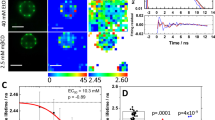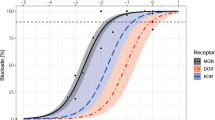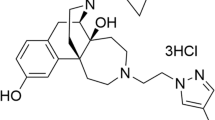Abstract
The purpose of this study was to test the hypothesis that activation of the dynorphin/kappa (κ)-opioid system has a role in the increased consumption of ethanol in dependent animals. The effects of three opioid receptor antagonists with different effects on opioid receptors, naltrexone, nalmefene, and nor-binaltorphimine (nor-BNI), were compared in their ability to decrease ethanol self-administration in nondependent and ethanol-dependent male Wistar rats. Nalmefene and naltrexone are both opioid receptor ligands with comparable molecular weights and pharmacokinetic profiles, but differing specificity for the three opioid receptor subtypes at low doses, while nor-BNI is a selective κ-opioid receptor antagonist. Dependence was induced in half the animals by subjecting them to a 4-week intermittent vapor exposure period in which animals were exposed to ethanol vapor for 14 h per day. Subsequent to dependence induction, nalmefene, naltrexone, and nor-BNI were tested for their ability to modulate self-administration of ethanol in vapor-exposed and control rats. The results indicated that both nalmefene and naltrexone induced a significant dose-dependent decrease in the number of lever presses for ethanol in both groups of animals. However, in ethanol-dependent animals, nalmefene was significantly more effective in suppressing ethanol intake than naltrexone. Nor-BNI selectively attenuated ethanol-dependent self-administration while leaving nondependent ethanol self-administration intact. Because naltrexone is primarily selective for the μ-opioid receptor, and nalmefene is primarily selective for the μ- and κ-opioid receptor subtypes, the fact that nalmefene demonstrates more suppression in dependent animals suggests that opioid systems distinct from the μ-regulated portion may be involved in the increased drinking seen during withdrawal in dependent animals. The results with nor-BNI confirm that κ-opioid receptor antagonism selectively decreases dependence-induced ethanol self-administration, which supports the hypothesis that dynorphin/κ-opioid systems are dysregulated in dependence and contribute to the increased drinking seen during acute withdrawal in dependent rats.
Similar content being viewed by others
Log in or create a free account to read this content
Gain free access to this article, as well as selected content from this journal and more on nature.com
or
References
Abbott FV, Franklin KB, Libman RB (1986). A dose-ratio comparison of mu and kappa agonists in formalin and thermal pain. Life Sci 39: 2017–2024.
Agmo A, Gomez M (1991). Conditioned place preference produced by infusion of Met-enkephalin into the medial preoptic area. Brain Res 550: 343–346.
Amalric M, Cline EJ, Martinez Jr JL, Bloom FE, Koob GF (1987). Rewarding properties of beta-endorphin as measured by conditioned place preference. Psychopharmacology (Berl) 91: 14–19.
Anderson WW, Thompson T (1974). Ethanol self-administration in water satiated rats. Pharmacol Biochem Behav 2: 447–454.
Anton RF, Pettinati H, Zweben A, Kranzler HR, Johnson B, Bohn MJ et al (2004). A multi-site dose ranging study of nalmefene in the treatment of alcohol dependence. J Clin Psychopharmacol 24: 421–428.
Bart G, Schluger JH, Borg L, Ho A, Bidlack JM, Kreek MJ (2005). Nalmefene induced elevation in serum prolactin in normal human volunteers: partial kappa opioid agonist activity? Neuropsychopharmacology 30: 2254–2262.
Belluzzi JD, Stein L (1977). Enkephaline may mediate euphoria and drive-reduction reward. Nature 266: 556–558.
Bozarth MA (1990). Evidence for the rewarding effects of ethanol using the conditioned place preference method. Pharmacol Biochem Behav 35: 485–487.
Chen F, Lawrence AJ (2000). Effect of chronic ethanol and withdrawal on the mu-opioid receptor- and 5-hydroxytryptamine(1A) receptor-stimulated binding of [(35)S]guanosine-5′-O-(3-thio)triphosphate in the fawn-hooded rat brain: a quantitative autoradiography study. J Pharmacol Exp Ther 293: 159–165.
Coonfield DL, Hill KG, Kaczmarek HJ, Ferraro III FM, Kiefer SW (2002). Low doses of naltrexone reduce palatability and consumption of ethanol in outbred rats. Alcohol 26: 43–47.
Cowen MS, Lawrence AJ (2001). Alterations in central preproenkephalin mRNA expression after chronic free-choice ethanol consumption by fawn-hooded rats. Alcohol Clin Exp Res 25: 1126–1133.
Dai X, Thavundayil J, Gianoulakis C (2005). Differences in the peripheral levels of beta-endorphin in response to alcohol and stress as a function of alcohol dependence and family history of alcoholism. Alcohol Clin Exp Res 29: 1965–1975.
Di Chiara G, Imperato A (1988a). Drugs abused by humans preferentially increase synaptic dopamine concentrations in the mesolimbic system of freely moving rats. Proc Natl Acad Sci USA 85: 5274–5278.
Di Chiara G, Imperato A (1988b). Opposite effects of mu and kappa opiate agonists on dopamine release in the nucleus accumbens and in the dorsal caudate of freely moving rats. J Pharmacol Exp Ther 244: 1067–1080.
Doyon WM, Howard EC, Shippenberg TS, Gonzales RA (2006). Kappa-opioid receptor modulation of accumbal dopamine concentration during operant ethanol self-administration. Neuropharmacology 51: 487–496.
Eckardt MJ, File SE, Gessa GL, Grant KA, Guerri C, Hoffman PL et al (1998). Effects of moderate alcohol consumption on the central nervous system. Alcohol Clin Exp Res 22: 998–1040.
Gianoulakis C, Krishnan B, Thavundayil J (1996). Enhanced sensitivity of pituitary beta-endorphin to ethanol in subjects at high risk of alcoholism. Arch Gen Psychiatry 53: 250–257.
Goeders NE, Lane JD, Smith JE (1984). Self-administration of methionine enkephalin into the nucleus accumbens. Pharmacol Biochem Behav 20: 451–455.
Gonzales RA, Weiss F (1998). Suppression of ethanol-reinforced behavior by naltrexone is associated with attenuation of the ethanol-induced increase in dialysate dopamine levels in the nucleus accumbens. J Neurosci 18: 10663–10671.
Holter SM, Henniger MS, Lipkowski AW, Spanagel R (2000). Kappa-opioid receptors and relapse-like drinking in long-term ethanol-experienced rats. Psychopharmacology (Berl) 153: 93–102.
Hubbell CL, Abelson ML, Burkhardt CA, Herlands SE, Reid LD (1988). Constant infusions of morphine and intakes of sweetened ethanol solution among rats. Alcohol 5: 409–415.
Hyytia P (1993). Involvement of mu-opioid receptors in alcohol drinking by alcohol-preferring AA rats. Pharmacol Biochem Behav 45: 697–701.
Jewett DC, Woods JH (1995). Nor-binaltorphimine: an ultra-long acting kappa-opioid antagonist in pigeons. Behav Pharmacol 6: 815–820.
June HL, Cummings R, Eiler WJ, Foster KL, McKay PF, Seyoum R et al (2004). Central opioid receptors differentially regulate the nalmefene-induced suppression of ethanol- and saccharin-reinforced behaviors in alcohol-preferring (P) rats. Neuropsychopharmacology 29: 285–299.
June HL, Grey C, Warren-Reese C, Durr LF, Ricks-Cord A, Johnson A et al (1998). The opioid receptor antagonist nalmefene reduces responding maintained by ethanol presentation: preclinical studies in ethanol-preferring and outbred Wistar rats. Alcohol Clin Exp Res 22: 2174–2185.
Koob GF, Caine SB, Parsons L, Markou A, Weiss F (1997). Opponent process model and psychostimulant addiction. Pharmacol Biochem Behav 57: 513–521.
Koob GF, Le Moal M (1997). Drug abuse: hedonic homeostatic dysregulation. Science 278: 52–58.
Koob GF, Le Moal M (2001). Drug addiction, dysregulation of reward, and allostasis. Neuropsychopharmacology 24: 97–129.
Koob GF, Roberts AJ, Kieffer BL, Heyser CJ, Katner SN, Ciccocioppo R et al (2003). Animal models of motivation for drinking in rodents with a focus on opioid receptor neuropharmacology. Recent Dev Alcohol 16: 263–281.
Krishnan-Sarin S, Wand GS, Li XW, Portoghese PS, Froehlich JC (1998). Effect of mu opioid receptor blockade on alcohol intake in rats bred for high alcohol drinking. Pharmacol Biochem Behav 59: 627–635.
Lindholm S, Ploj K, Franck J, Nylander I (2000). Repeated ethanol administration induces short- and long-term changes in enkephalin and dynorphin tissue concentrations in rat brain. Alcohol 22: 165–171.
Mague SD, Pliakas AM, Todtenkopf MS, Tomasiewicz HC, Zhang Y, Stevens Jr WC et al (2003). Antidepressant-like effects of kappa-opioid receptor antagonists in the forced swim test in rats. J Pharmacol Exp Ther 305: 323–330.
Marglin SH, MacKechnie DK, Mattie ME, Hui YH, Reid LD (1988). Ethanol with small doses of morphine establishes a conditioned place preference. Alcohol 5: 309–313.
Margolis EB, Hjelmstad GO, Bonci A, Fields HL (2003). Kappa-opioid agonists directly inhibit midbrain dopaminergic neurons. J Neurosci 23: 9981–9986.
Margolis EB, Lock H, Chefer VI, Shippenberg TS, Hjelmstad GO, Fields HL (2006). Kappa opioids selectively control dopaminergic neurons projecting to the prefrontal cortex. Proc Natl Acad Sci USA 103: 2938–2942.
Marinelli PW, Bai L, Quirion R, Gianoulakis C (2005). A microdialysis profile of Met-enkephalin release in the rat nucleus accumbens following alcohol administration. Alcohol Clin Exp Res 29: 1821–1828.
Marinelli PW, Lam M, Bai L, Quirion R, Gianoulakis C (2006). A microdialysis profile of dynorphin A(1-8) release in the rat nucleus accumbens following alcohol administration. Alcohol Clin Exp Res 30: 982–990.
Marinelli PW, Quirion R, Gianoulakis C (2003). A microdialysis profile of beta-endorphin and catecholamines in the rat nucleus accumbens following alcohol administration. Psychopharmacology (Berl) 169: 60–67.
Marinelli PW, Quirion R, Gianoulakis C (2004). An in vivo profile of beta-endorphin release in the arcuate nucleus and nucleus accumbens following exposure to stress or alcohol. Neuroscience 127: 777–784.
Mason BJ, Ritvo EC, Morgan RO, Salvato FR, Goldberg G, Welch B et al (1994). A double-blind, placebo-controlled pilot study to evaluate the efficacy and safety of oral nalmefene HCl for alcohol dependence. Alcohol Clin Exp Res 18: 1162–1167.
McLaughlin JP, Marton-Popovici M, Chavkin C (2003). Kappa opioid receptor antagonism and prodynorphin gene disruption block stress-induced behavioral responses. J Neurosci 23: 5674–5683.
Michel ME, Bolger G, Weissman BA (1985). Binding of a new opiate antagonist, nalmefene, to rat brain membranes. Methods Find Exp Clin Pharmacol 7: 175–177.
Millan MJ (1989). Kappa-opioid receptor-mediated antinociception in the rat. I. Comparative actions of mu- and kappa-opioids against noxious thermal, pressure and electrical stimuli. J Pharmacol Exp Ther 251: 334–341.
Millan MJ, Czlonkowski A, Lipkowski A, Herz A (1989). Kappa-opioid receptor-mediated antinociception in the rat. II. Supraspinal in addition to spinal sites of action. J Pharmacol Exp Ther 251: 342–350.
Mucha RF, Herz A (1985). Motivational properties of kappa and mu opioid receptor agonists studied with place and taste preference conditioning. Psychopharmacology (Berl) 86: 274–280.
Newton SS, Thome J, Wallace TL, Shirayama Y, Schlesinger L, Sakai N et al (2002). Inhibition of cAMP response element-binding protein or dynorphin in the nucleus accumbens produces an antidepressant-like effect. J Neurosci 22: 10883–10890.
O'Dell LE, Roberts AJ, Smith RT, Koob GF (2004). Enhanced alcohol self-administration after intermittent versus continuous alcohol vapor exposure. Alcohol Clin Exp Res 28: 1676–1682.
Paxinos G, Watson C (2005). The Rat Brain in Stereotaxic Coordinates. Elsevier, Academic Press: San Diego.
Picker MJ, Mathewson C, Allen RM (1996). Opioids and rate of positively reinforced behavior: III. Antagonism by the long-lasting kappa antagonist norbinaltorphimine. Behav Pharmacol 7: 495–504.
Pliakas AM, Carlson RR, Neve RL, Konradi C, Nestler EJ, Carlezon Jr WA (2001). Altered responsiveness to cocaine and increased immobility in the forced swim test associated with elevated cAMP response element-binding protein expression in nucleus accumbens. J Neurosci 21: 7397–7403.
Przewlocka B, Turchan J, Lason W, Przewlocki R (1997). Ethanol withdrawal enhances the prodynorphin system activity in the rat nucleus accumbens. Neurosci Lett 238: 13–16.
Reid LD (1996). Endogenous opioids and alcohol dependence: opioid alkaloids and the propensity to drink alcoholic beverages. Alcohol 13: 5–11.
Roberts AJ, Cole M, Koob GF (1996). Intra-amygdala muscimol decreases operant ethanol self-administration in dependent rats. Alcohol Clin Exp Res 20: 1289–1298.
Roberts AJ, Heyser CJ, Cole M, Griffin P, Koob GF (2000). Excessive ethanol drinking following a history of dependence: animal model of allostasis. Neuropsychopharmacology 22: 581–594.
Rogers J, Wiener SG, Bloom FE (1979). Long-term ethanol administration methods for rats: advantages of inhalation over intubation or liquid diets. Behav Neural Biol 27: 466–486.
Rosin A, Lindholm S, Franck J, Georgieva J (1999). Downregulation of kappa opioid receptor mRNA levels by chronic ethanol and repetitive cocaine in rat ventral tegmentum and nucleus accumbens. Neurosci Lett 275: 1–4.
Rubin DB (1987). Multiple Imputation for Nonresponse in Surveys. J. Wiley & Sons: New York.
Rubin DB (1996). Multiple imputation after 18+ years. Journal of the American Statistical Association 91: 473–489.
Samson HH (1986). Initiation of ethanol reinforcement using a sucrose-substitution procedure in food- and water-sated rats. Alcohol Clin Exp Res 10: 436–442.
Schafer JL (1999). Multiple imputation: a primer. Stat Methods Med Res 8: 3–15.
Schafer JL, Graham JW (2002). Missing data: our view of the state of the art. Psychol Methods 7: 147–177.
Schulteis G, Markou A, Cole M, Koob GF (1995). Decreased brain reward produced by ethanol withdrawal. Proc Natl Acad Sci USA 92: 5880–5884.
Shirayama Y, Ishida H, Iwata M, Hazama GI, Kawahara R, Duman RS (2004). Stress increases dynorphin immunoreactivity in limbic brain regions and dynorphin antagonism produces antidepressant-like effects. J Neurochem 90: 1258–1268.
Shoemaker WJ, Vavrousek-Jakuba E, Arons CD, Kwok FC (2002). The acquisition and maintenance of voluntary ethanol drinking in the rat: effects of dopaminergic lesions and naloxone. Behav Brain Res 137: 139–148.
Smith SG, Davis WM (1974). Intravenous alcohol self-administration in the rat. Pharmacol Res Commun 6: 379–402.
Solomon RL, Corbit JD (1974). An opponent-process theory of motivation. I. Temporal dynamics of affect. Psychol Rev 81: 119–145.
Stromberg MF (2004). The effect of baclofen alone and in combination with naltrexone on ethanol consumption in the rat. Pharmacol Biochem Behav 78: 743–750.
Stromberg MF, Casale M, Volpicelli L, Volpicelli JR, O'Brien CP (1998). A comparison of the effects of the opioid antagonists naltrexone, naltrindole, and beta-funaltrexamine on ethanol consumption in the rat. Alcohol 15: 281–289.
Stromberg MF, Mackler SA, Volpicelli JR, O'Brien CP (2001). Effect of acamprosate and naltrexone, alone or in combination, on ethanol consumption. Alcohol 23: 109–116.
Turchan J, Przewlocka B, Toth G, Lason W, Borsodi A, Przewlocki R (1999). The effect of repeated administration of morphine, cocaine and ethanol on mu and delta opioid receptor density in the nucleus accumbens and striatum of the rat. Neuroscience 91: 971–977.
Volpicelli JR, Alterman AI, Hayashida M, O'Brien CP (1992). Naltrexone in the treatment of alcohol dependence. Arch Gen Psychiatry 49: 876–880.
Walker BM, Ettenberg A (2007). Intracerebroventricular ethanol-induced conditioned place preferences are prevented by fluphenazine infusions into the nucleus accumbens of rats. Behav Neurosci 21: 401–410.
Walker BM, Koob GF (2007). The GABAB receptor agonist baclofen attenuates operant responding for ethanol in ethanol-dependant rats. Alcohol Clin Exp Res 31: 11–18.
Walker EA, Makhay MM, House JD, Young AM (1994). In vivo apparent pA2 analysis for naltrexone antagonism of discriminative stimulus and analgesic effects of opiate agonists in rats. J Pharmacol Exp Ther 271: 959–968.
Acknowledgements
Support for this Research was provided by National Institute on Alcohol Abuse and Alcoholism grants awarded to GFK (AA012602) and a National Research Service Award awarded to BMW (AA014723). We thank Dr. Eric Zorrilla for his statistical advice, Maury Cole, Mallinckrodt Inc., and The Pearson Center for Alcoholism and Addiction Research for their assistance with this project and Mike Arends for editorial assistance.
Author information
Authors and Affiliations
Corresponding author
Additional information
Disclosures
Neither of the authors has any conflicts of interest related or unrelated to this manuscript.
Rights and permissions
About this article
Cite this article
Walker, B., Koob, G. Pharmacological Evidence for a Motivational Role of κ-Opioid Systems in Ethanol Dependence. Neuropsychopharmacol 33, 643–652 (2008). https://doi.org/10.1038/sj.npp.1301438
Received:
Revised:
Accepted:
Published:
Issue date:
DOI: https://doi.org/10.1038/sj.npp.1301438
Keywords
This article is cited by
-
Systemic kappa opioid receptor antagonism accelerates reinforcement learning via augmentation of novelty processing in male mice
Neuropsychopharmacology (2023)
-
Pharmacologic hyperreactivity of kappa opioid receptors in periaqueductal gray matter during alcohol withdrawal syndrome in rats
Pharmacological Reports (2023)
-
Kappa opioid receptor and dynorphin signaling in the central amygdala regulates alcohol intake
Molecular Psychiatry (2021)
-
GPCR and Alcohol-Related Behaviors in Genetically Modified Mice
Neurotherapeutics (2020)
-
Sex differences in neural mechanisms mediating reward and addiction
Neuropsychopharmacology (2019)



